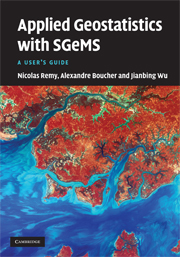Nicolas Remy, Alexandre Boucher and Jianbing Wu
Published by: Cambridge University Press
Publication date: 2009
ISBN: 978-0-52151-414-9 (hbk)
List price: £50.00
264 pp plus CD-ROM containing SGeMS
www.cambridge.org

At last! Here is a publisher who has prepared a thoroughly practical and well presented guide to geostatistics, together with software in a form that can be run by most on their own computers. This attractively printed volume includes a brief overview of spatial statistics (geostatistics) before going on to demonstrate how basic data can be treated. The book then develops concepts of modelling including simulation and analysis.
Two decades have passed since the release of GeoEAS (Geostatistical Environmental Assessment Software) by the US Environmental Protection Agency, the first geostatistical package to be made freely available and in a form suitable for teaching as well as basic geostatistical processing. However, it is limited to 2-D data and runs in a DOS environment, and so it is somewhat alien to today’s students. Furthermore, although the source code was later released, it does not readily lend itself to modification by the user. A decade ago GSLIB (Geostatistical Software Library) filled this gap, enabling modules to be compiled and readily rewritten to suit the user’s needs. The source code was suitable for running in a DOS environment but in compiled form was also available for Windows, for those who paid an appropriate registration fee.
Able to read data in similar format, SGeMS (Stanford Geostatistical Modelling Software) has now been released by staff associated with the Centre for Reservoir Forecasting at Stanford University, with the object of providing a basic and adaptable package “for solving problems involving spatially related variables. It provides geostatistics practitioners with a user-friendly interface, an interactive 3-D visualisation and a selection of algorithms”. There are two main groups of algorithm: kriging (ordinary, indicator, cokriging and block kriging) and simulation (variogram-based, such as Gaussian and sequential, and multiple point), together with utilities to facilitate data transformation.
The book will prove a valuable companion to anyone learning to run the software. It is not, however, an introductory text on geostatistics nor is it a software manual per se. The former is already well catered for by published textbooks and the latter can be downloaded from the support website, together with an example data file concerning porosity that is used in the book. The constraints provided by known and modelled outcrops of sand channels produce striking simulations that are likely to be particularly attractive to geoscientists concerned with environmental and hydrocarbon investigations. The accompanying CD-ROM contains the full SGeMS software and there is a web site to support users in their endeavours:
http://sgems.sourceforge.net/. The approach will be intuitive to those already familiar with GeoEAS and GSLIB, and hopefully can be readily followed by others.
This book is recommended for those wishing to conduct their own geostatistical modelling and analysis, and is suitable for students and practitioners alike.
Mike Rosenbaum
Ludlow